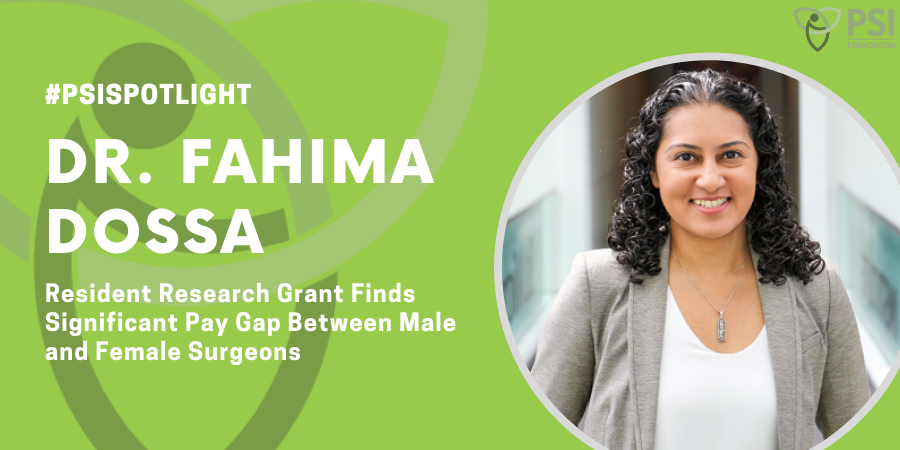“PSI’s Resident Research Grant gives you complete ownership over the project, and you gain important skills in grant writing, finances, and leading projects. For someone like me, who is interested in a career in research, these elements are going to be important in my future, and having a resident-focused grant gives you some of those skills that are important to any scientist.” – Dr. Fahima Dossa, general surgery resident, University of Toronto
Based on their own experiences in medical school and as training and practicing surgeons, Dr. Dossa and her supervisor, Dr. Nancy Baxter, a colorectal surgeon at St. Michael’s Hospital in Toronto, became interested in exploring biases against female surgeons.
“Surgery happens to be an area where there’s still a lot of systemic bias against women,” says Dr. Dossa. “For example, as women go through medical school, they are often still discouraged from going into surgery, or if they pick surgery, they’re encouraged to go into certain areas of surgery that are still considered ‘women’s work.”
In recent years, research from salary-based systems in the US has found pay gaps between male and female surgeons, which was attributed to practice patterns and time spent operating. A fee-for-service system has been thought to be more equitable, but Dr. Dossa and Dr. Baxter wondered if this was actually the case in Ontario.
Dr. Dossa received a PSI Resident Research Grant to study this question using data from Ontario’s fee-for-service system. She examined 1.5 million surgical procedures billed from 2014 to 2016 to see if there were differences in the amount of time spent operating and in the hourly earnings of male and female surgeons.
She found that there was no difference in the amount of time that male and female surgeons spent operating, but that the pay gap between male and female surgeons in Ontario was about the same as the salary-based systems.
Considering all surgeries together, male surgeons earned nearly $65 US more per hour than female surgeons. Even within specialties, male surgeons earned significantly more per hour, ranging from $17 more per hour more in gynecology to nearly $60 more per hour for cardiothoracic surgery.
When Dr. Dossa examined the reasons for these differences, she found that female surgeons were more common in the specialties that remunerated less (for example, gynecology and general surgery) and that, in all specialties, they performed more of the procedures that remunerate at lower amounts; male surgeons, on the other hand, tended to perform more of the higher-paying procedures.
“Unfortunately, it was not surprising and lined up with our anecdotal experiences,” says Dr. Dossa. “But I think it was helpful and illuminating to show that a fee-for-service system is not the solution to the pay gap, and we finally had some data to back that up.”
Dr. Dossa hopes that results will lead to policy change to make system more equitable
Since the initial study, Dr. Dossa and Dr. Baxter have undertaken a follow-up study to understand whether there is bias against female surgeons in the referral system that leads to them performing fewer higher-paying procedures. They have examined 20 years of referral data to look for patterns in whether male and female physicians refer to surgeons of the same sex, even if they have the same amount of experience. The results are currently being reviewed for publication.
Research outside of specific conditions or patient populations is beyond the scope of what many research agencies will fund, and Dr. Dossa knew that PSI Foundation would be a key supporter of the work.
“It’s hard to find funding that is geared at questions that are relevant to physicians,” she says. “PSI seemed like a natural opportunity to acquire funding specifically for a project that is relevant to equity among physicians.”
The results were published in JAMA Surgery in 2019 and generated a lot of conversation in the community. Dr. Dossa hopes that the conversation will now shift to action.
“The medical community has seen the data, and now is the time that we make some change based on the data,” she says. “It would be nice to transition more to implementation and policy and see some change come from studies like this.”
Those changes might include greater transparency in what surgeons in the same specialty at the same hospital are paid, as well as having more women involved in negotiating the fee schedule so that procedures that are complex or time-consuming but more often performed by women are remunerated appropriately.
Another change that could help is a centralized referral system, instead of relying on physicians individually selecting surgeons.
“The COVID-19 pandemic has actually opened an opportunity to explore that idea. We have a huge surgical backload, and it may no longer make sense to pick and choose which surgeon you want to refer to,” she says. “It may actually expedite care to have a centralized process, and if that’s appropriately implemented, you can imagine how it could help quell some of the biases that we’re seeing.”



